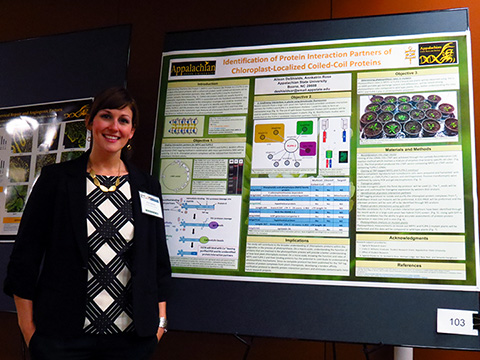 |
Dr. Annkatrin RosePlant Molecular Biologist |
||
|
COURSES |
Identification of Protein Interaction Partners of Chloroplast-localized Coild-coil ProteinsAlison DeShields, Annkatrin Rose MAR-binding Filament-like Protein 1 (MFP1) and Filament-like Protein 4-2 (FLIP4-2) are unique chloroplast proteins with a coiled-coil protein motif. Coiled-coil domains act as protein-protein interaction partners; thus, MFP1 and FLIP4-2 may be involved in protein complex formations. Coiled-coil protein motifs are usually found in eukaryotic organelles; however, MFP1 is associated with the thylakoid membrane; also, FLIP4-2 is thought to be located in the chloroplast envelope and could be involved in vesicle transport to form thylakoids. Our goal is to identify and further investigate MFP1, FLIP4-2, and the proteins that interact with MFP1 and FLIP4-2 and how they may contribute to the eukaryotic-type features of chloroplasts found in land plants, and the direct or indirect involvement in photosynthetic processes. To identify chloroplast-localized binding proteins of MFP1 and FLIP4-2, tandem affinity purification (TAP) tagging method in combination with mass spectrometry will be used. The TAP method uses a fusion of the TAP tag to the protein of interest. Protein complexes with the TAP-tagged protein can be purified by two affinity purification steps. An objective for the project is to develop a TAP tagging protocol to isolate chloroplast protein complexes from transformed Arabidopsis thaliana plants. Recent research from a large scale yeast-two hybrid analysis provided candidate interaction partners for FLIP4-2 and FLIP4-1 in Arabidopsis thaliana. The use of split-Green Fluorescent Protein analysis will be used to confirm if these interactions happen in plants. Since MFP1 and FLIP4-2 proteins are located in chloroplast organelles, photosynthesis may be altered in plants lacking MFP1 or FLIP4-2. Photosynthesis rates in MFP1 or FLIP4-2 knock-out plants will be observed using the Li-cor 6400 portable gas exchange system and differences will be noted among photosynthesis rates compared to wild type plants, thus; better understanding the roles MFP1 and FLIP4-2 play in photosynthetic processes. This study will contribute to the broader understanding of chloroplastic proteins. Understanding the function of proteins that are involved in the photosynthetic process will provide a better understanding of how land plant chloroplasts evolved; also, understanding the function and roles of MFP1 and FLIP4-2 and their binding proteins has the potential to contribute to understanding photosynthetic mechanisms. Poster # 103 at the Science in the Mountains Meeting, Appalachian State University, NC, April 11-12, 2013.
|
||
